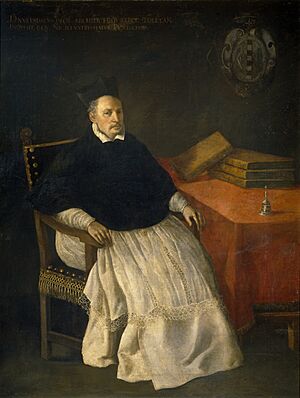Diego de Deza facts for kids
Diego de Deza y Tavera (born 1444 – died June 9, 1523) was an important religious leader and a judge in a special religious court in Spain. He was a very well-known figure in the Spanish Inquisition. He took over from Tomás de Torquemada as the Grand Inquisitor, who was the main leader of this court.
Contents
Early Life and Important Roles
Deza was born in a town called Toro, Zamora. He joined the Dominican Order, a group of religious people, when he was quite young.
He held many important church jobs. He also taught Prince Juan de Aragón y Castilla, who was the only son of King Ferdinand and Queen Isabella.
Diego de Deza played a key part in helping the famous explorer Christopher Columbus meet with Queen Isabella and King Ferdinand. This meeting was very important for Columbus's voyages.
Before becoming the Archbishop of Seville, he served as a bishop in several cities. These included Zamora (from 1487 to 1494), Salamanca (from 1494 to 1498), Jaén (from 1498 to 1500), and Palencia (from 1500 to 1504). In 1505, he became the Archbishop of Seville.
On November 24, 1498, Deza was chosen to be the Grand Inquisitor for Castile, León, and Granada. A year later, his power grew to cover all of Spain.
Leading the Inquisition
Deza followed Tomás de Torquemada as Grand Inquisitor. Torquemada was perhaps the most famous leader of the Inquisition. Like Torquemada, Deza was very strict with people called conversos. These were Jews or Muslims who had changed their religion to Christianity. However, they were often accused of secretly keeping their old faith.
It is said that soon after he arrived in Palencia, he helped many "moriscos" (Muslims who had converted) get baptized on April 25, 1500. This day was Saint Marcus day, and because of this, a street once called "Morería" is now known as "San Marcos" street.
After Queen Isabella I of Castile died, Deza had to attend important meetings. He met with King Consort Ferdinand II of Aragon and Cardinal Francisco Ximenez de Cisneros.
When he arrived in Seville in October 1505, Deza worked to convert many Sevillian Muslims and Jews to Christianity. He also led investigations in the new Archbishopric of Granada. Granada had been conquered in 1492, and promises to respect the religious beliefs of Muslims there were later not kept.
Some people said that Deza was too strict and harsh in his work. His reputation was such that in 1507, the Pope had to publicly ask him to be more moderate. There were also accusations that Deza used his position to become rich. He was said to take the money of people accused of not truly following the Christian faith. One complaint said that Deza and his helpers "had no regard for God or for justice."
Challenges and Downfall

Later, Deza himself was accused of secretly practicing Judaism. This charge was mainly because his mother's family had Jewish roots. This accusation was likely made for political reasons, but it still hurt his standing.
His position became even weaker because of several protests against the Inquisition. These protests were especially against his main helper, Diego Rodriguez Lucero. Lucero strongly disliked those he believed were "false converts."
Diego Rodriguez Lucero, the Inquisitor of Córdoba, was even more disliked than Deza. In late 1506, he barely escaped with his life when an angry mob attacked the Inquisition's building in Cordoba. The mob freed all the prisoners there. Pope Julius II seemed to ignore some of the investigations by Deza and Lucero.
After King Ferdinand II of Aragon got married again, he decided that Deza was causing too many problems. Because of this, Deza was forced to leave his position in 1507.
In 1517, Diego de Deza started the "Colegio de Santo Tomás" in Seville. This was 15 years after Rodrigo Fernández de Santaella had founded the "Colegio de Santa María de Jesus," which later became the University of Seville.
Later Life and Death
It is thought that Diego de Deza might have returned to his work with the Inquisition. He was named Archbishop of Toledo, which is a very important church position in Spain. However, he could not take the job because he became ill. He passed away on June 9, 1523.
His tomb in his College of Santo Tomas was opened by soldiers during the Napoleonic Wars in 1810. They were looking for his rings and other valuable items. Later, the college became a military building. The wife of a high-ranking military officer visited often. She became interested in his empty tomb and thought it would be useful as a bath for her beauty routine.
Helping Other Bishops
While he was a bishop, Diego de Deza helped other important church leaders get their positions. He was the main person who officially appointed:
- Alonso Manso, Bishop of Puerto Rico (1512);
- Pedro Suárez de Deza, Bishop of Concepción de la Vega (1512);
- Juan de Quevedo Villegas, Bishop of Santa María de La Antigua del Darién (1514).
He also helped appoint:
- Pascual Rebenga de Ampudia, Bishop of Burgos (1497).
See also
 In Spanish: Diego de Deza para niños
In Spanish: Diego de Deza para niños


